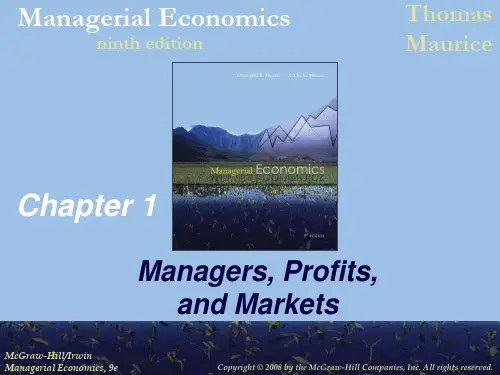管理经济学英文版
- 格式:pptx
- 大小:334.62 KB
- 文档页数:14
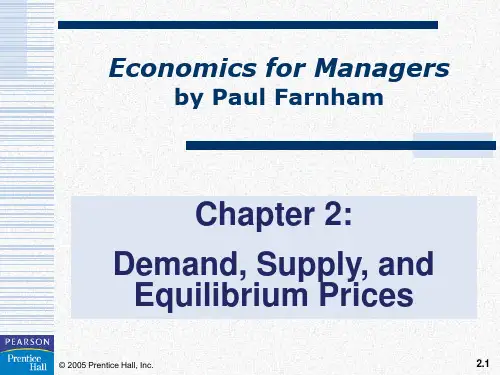
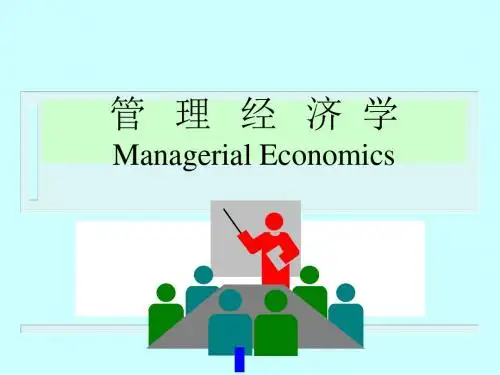
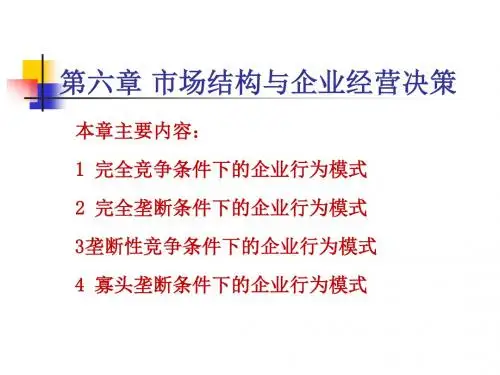
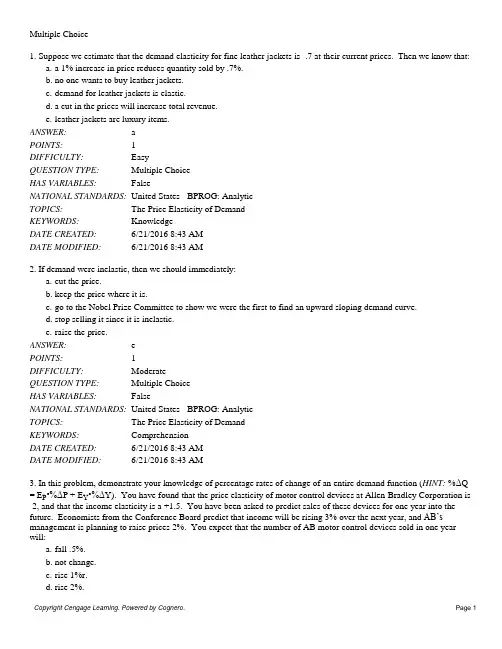
Multiple Choice1. Suppose we estimate that the demand elasticity for fine leather jackets is -.7 at their current prices. Then we know that:a. a 1% increase in price reduces quantity sold by .7%.b. n o one wants to buy leather jackets.c. d emand for leather jackets is elastic.d. a cut in the prices will increase total revenue.e. l eather jackets are luxury items.ANSWER: aPOINTS: 1DIFFICULTY: EasyQUESTION TYPE: Multiple ChoiceHAS VARIABLES: FalseNATIONAL STANDARDS: U nited States - BPROG: AnalyticTOPICS: The Price Elasticity of DemandKEYWORDS: KnowledgeDATE CREATED: 6/21/2016 8:43 AMDATE MODIFIED: 6/21/2016 8:43 AM2. If demand were inelastic, then we should immediately:a. c ut the price.b. k eep the price where it is.c. g o to the Nobel Prize Committee to show we were the first to find an upward sloping demand curve.d. s top selling it since it is inelastic.e. r aise the price.ANSWER: ePOINTS: 1DIFFICULTY: ModerateQUESTION TYPE: Multiple ChoiceHAS VARIABLES: FalseNATIONAL STANDARDS: U nited States - BPROG: AnalyticTOPICS: The Price Elasticity of DemandKEYWORDS: ComprehensionDATE CREATED: 6/21/2016 8:43 AMDATE MODIFIED: 6/21/2016 8:43 AM3. In this problem, demonstrate your knowledge of percentage rates of change of an entire demand function (HINT: %ΔQ = E P•%ΔP + E Y•%ΔY). You have found that the price elasticity of motor control devices at Allen-Bradley Corporation is -2, and that the income elasticity is a +1.5. You have been asked to predict sales of these devices for one year into the future. Economists from the Conference Board predict that income will be rising 3% over the next year, and AB’s management is planning to raise prices 2%. You expect that the number of AB motor control devices sold in one year will:a. f all .5%.b. n ot change.c. r ise 1%r.d. r ise 2%.e. r ise .5%.ANSWER: ePOINTS: 1DIFFICULTY: ChallengingQUESTION TYPE: Multiple ChoiceHAS VARIABLES: FalseNATIONAL STANDARDS: U nited States - BPROG: Reflective Thinking - BPROG: AnalysisTOPICS: Cross Elasticity of DemandKEYWORDS: BLOOMS: ApplicationDATE CREATED: 6/21/2016 8:43 AMDATE MODIFIED: 6/21/2016 8:43 AM4. A linear demand for lake front cabins on a nearby lake is estimated to be: Q D = 900,000 - 2P. What is the point price elasticity for lake front cabins at a price of P = $300,000? [HINT: E p = (∂Q/∂P)(P/Q)]a. EP = -3.0b. EP = -2.0c. EP = -1.0d. EP = -0.5e. EP = 0ANSWER: bPOINTS: 1DIFFICULTY: ChallengingQUESTION TYPE: Multiple ChoiceHAS VARIABLES: FalseNATIONAL STANDARDS: U nited States - BPROG: Reflective Thinking - BPROG: AnalysisTOPICS: The Price Elasticity of DemandKEYWORDS: BLOOM’S: ComprehensionDATE CREATED: 6/21/2016 8:43 AMDATE MODIFIED: 6/21/2016 8:43 AM5. Property taxes are the product of the tax rate (T) and the assessed value (V). The total property tax collected in your city (P) is: P = T•V. If the value of properties rise 4% and if Mayor and City Council reduces the property the tax rate by 2%, what happens to the total amount of property tax collected? [HINT: the percentage rate of change of a product is approximately the sum of the percentage rates of change.}a. I t rises 6 %.b. I t rises 4 %.c. I t rises 3 %.d. I t rises 2 %e. I f falls 2%.ANSWER: dPOINTS: 1DIFFICULTY: ModerateQUESTION TYPE: Multiple ChoiceHAS VARIABLES: FalseNATIONAL STANDARDS: U nited States - BPROG: Reflective Thinking - BPROG: AnalysisTOPICS: Cross Elasticity of DemandKEYWORDS: BLOOM’S: ComprehensionDATE CREATED: 6/21/2016 8:43 AMDATE MODIFIED: 6/21/2016 8:43 AM6. Demand is given by Q D = 620 - 10·P and supply is given by Q S = 100 + 3·P. What is the price and quantity when the market is in equilibrium?a. T he price will be $30 and the quantity will be 132 units.b. T he price will be $11 and the quantity will be 122 units.c. T he price will be $40 and the quantity will be 220 units.d. T he price will be $35 and the quantity will be 137 unitse. T he price will be $10 and the quantity will be 420 units.ANSWER: cPOINTS: 1DIFFICULTY: ModerateQUESTION TYPE: Multiple ChoiceHAS VARIABLES: FalseNATIONAL STANDARDS: U nited States - BPROG: AnalyticTOPICS: BLOOM’S: ComprehensionKEYWORDS: BPROG: AnalyticDATE CREATED: 6/21/2016 8:43 AMDATE MODIFIED: 6/21/2016 8:43 AM7. Which of the following would tend to make demand INELASTIC?a. t he amount of time analyzed is quite longb. t here are lots of substitutes availablec. t he product is highly durabled. t he proportion of the budget spent on the item is very smalle. n o one really wants the product at allANSWER: dPOINTS: 1DIFFICULTY: EasyQUESTION TYPE: Multiple ChoiceHAS VARIABLES: FalseNATIONAL STANDARDS: U nited States - BPROG: AnalyticTOPICS: The Price Elasticity of DemandKEYWORDS: BLOOM’S: KnowledgeDATE CREATED: 6/21/2016 8:43 AMDATE MODIFIED: 6/21/2016 8:43 AM8. Which of the following best represents management's objective(s) in utilizing demand analysis?a. i t provides insights necessary for the effective manipulation of demandb. i t helps to measure the efficiency of the use of company resourcesc. i t aids in the forecasting of sales and revenuesd. a and be. a and cANSWER: ePOINTS: 1DIFFICULTY: EasyQUESTION TYPE: Multiple ChoiceHAS VARIABLES: FalseNATIONAL STANDARDS: U nited States - BPROG: AnalyticTOPICS: The Income Elasticity of DemandKEYWORDS: BLOOM’S: KnowledgeDATE CREATED: 6/21/2016 8:43 AMDATE MODIFIED: 7/23/2016 3:14 PM9. Identify the reasons why the quantity demanded of a product increases as the price of that product decreases.a. a s the price declines, the real income of the consumer increasesb. a s the price of product A declines, it makes it more attractive than product Bc. a s the price declines, the consumer will always demand more on each successive price reductiond. a and be. a and cANSWER: dPOINTS: 1DIFFICULTY: EasyQUESTION TYPE: Multiple ChoiceHAS VARIABLES: FalseNATIONAL STANDARDS: U nited States - BPROG: AnalyticTOPICS: Demand RelationshipsKEYWORDS: BLOOM’S: KnowledgeDATE CREATED: 6/21/2016 8:43 AMDATE MODIFIED: 7/23/2016 3:15 PM10. An increase in the quantity demanded could be caused by:a. a n increase in the price of substitute goodsb. a decrease in the price of complementary goodsc. a n increase in consumer income levelsd. a ll of the abovee. n one of the aboveANSWER: dPOINTS: 1DIFFICULTY: ModerateQUESTION TYPE: Multiple ChoiceHAS VARIABLES: FalseNATIONAL STANDARDS: U nited States - BPROG: AnalyticTOPICS: Demand RelationshipsKEYWORDS: BLOOM’S: ComprehensionDATE CREATED: 6/21/2016 8:43 AMDATE MODIFIED: 6/21/2016 8:43 AM11. Goods having a negative calculated income elasticity are...a. s uperior goodsb. p roducers' goodsc. n ondurable goodsd. i nferior goodse. n one of the aboveANSWER: dPOINTS: 1DIFFICULTY: EasyQUESTION TYPE: Multiple ChoiceHAS VARIABLES: FalseNATIONAL STANDARDS: U nited States - BPROG: AnalyticTOPICS: The Income Elasticity of DemandKEYWORDS: BLOOM’S: KnowledgeDATE CREATED: 6/21/2016 8:43 AMDATE MODIFIED: 7/20/2016 12:21 PM12. If the cross price elasticity measured between items A and B is positive, the two products are referred to as:a. c omplementsb. s ubstitutesc. i nelastic as compared to each otherd. b oth b and ce. a, b, and cANSWER: bPOINTS: 1DIFFICULTY: EasyQUESTION TYPE: Multiple ChoiceHAS VARIABLES: FalseNATIONAL STANDARDS: U nited States - BPROG: AnalyticTOPICS: Cross Elasticity of DemandKEYWORDS: BLOOM’S: KnowledgeDATE CREATED: 6/21/2016 8:43 AMDATE MODIFIED: 7/23/2016 3:17 PM13. When demand is ____ a percentage change in ____ is exactly offset by the same percentage change in ____ demanded, the net result being a constant total consumer expenditure.a. e lastic; price; quantityb. u nit elastic; price; quantityc. i nelastic; quantity; priced. i nelastic; price; quantitye. n one of the aboveANSWER: bPOINTS: 1DIFFICULTY: ModerateQUESTION TYPE: Multiple ChoiceHAS VARIABLES: FalseNATIONAL STANDARDS: U nited States - BPROG: Reflective Thinking - BPROG: AnalysisTOPICS: The Price Elasticity of DemandKEYWORDS: BLOOM’S: ComprehensionDATE CREATED: 6/21/2016 8:43 AMDATE MODIFIED: 6/21/2016 8:43 AM14. Marginal revenue (MR) is ____ when total revenue is maximized.a. g reater than oneb. e qual to onec. l ess than zerod. e qual to zeroe. e qual to minus oneANSWER: dPOINTS: 1DIFFICULTY: ModerateQUESTION TYPE: Multiple ChoiceHAS VARIABLES: FalseNATIONAL STANDARDS: U nited States - BPROG: Reflective Thinking - BPROG: AnalysisTOPICS: The Price Elasticity of DemandKEYWORDS: BLOOM’S: ComprehensionDATE CREATED: 6/21/2016 8:43 AMDATE MODIFIED: 6/21/2016 8:43 AM15. The factor(s) which cause(s) a movement along the demand curve include(s):a. i ncrease in level of advertisingb. d ecrease in price of complementary goodsc. i ncrease in consumer disposable incomed. d ecrease in price of the good demandede. a ll of the aboveANSWER: dPOINTS: 1DIFFICULTY: EasyQUESTION TYPE: Multiple ChoiceHAS VARIABLES: FalseNATIONAL STANDARDS: U nited States - BPROG: AnalyticTOPICS: Demand RelationshipsKEYWORDS: BLOOM’S: KnowledgeDATE CREATED: 6/21/2016 8:43 AMDATE MODIFIED: 6/21/2016 8:43 AM16. An increase in each of the following factors would normally provide a subsequent increase in quantity demanded, except:a. p rice of substitute goodsb. l evel of competitor advertisingc. c onsumer income leveld. c onsumer desires for goods and servicese. a and bANSWER: bPOINTS: 1DIFFICULTY: ModerateQUESTION TYPE: Multiple ChoiceHAS VARIABLES: FalseNATIONAL STANDARDS: U nited States - BPROG: AnalyticTOPICS: The Price Elasticity of DemandKEYWORDS: BLOOM’S: ComprehensionDATE CREATED: 6/21/2016 8:43 AMDATE MODIFIED: 7/23/2016 3:19 PM17. Durable goods are:a. c onsumers' goodsb. r aw materials combined to produce consumer goodsc. t hose that must be replaced after each used. t hose that may be stored and repairede. n one of the aboveANSWER: dPOINTS: 1DIFFICULTY: EasyQUESTION TYPE: Multiple ChoiceHAS VARIABLES: FalseNATIONAL STANDARDS: U nited States - BPROG: AnalyticTOPICS: Demand RelationshipsKEYWORDS: BLOOM’S: KnowledgeDATE CREATED: 6/21/2016 8:43 AMDATE MODIFIED: 7/20/2016 12:52 PM18. The demand for durable goods tends to be more price elastic than the demand for non-durables.a. t rueb. f alseANSWER: aPOINTS: 1DIFFICULTY: EasyQUESTION TYPE: Multiple ChoiceHAS VARIABLES: FalseNATIONAL STANDARDS: U nited States - BPROG: AnalyticTOPICS: Demand RelationshipsKEYWORDS: BLOOM’S: ComprehensionDATE CREATED: 6/21/2016 8:43 AMDATE MODIFIED: 7/23/2016 3:27 PM19. A price elasticity (E D) of −1.50 indicates that for a ____ increase in price, quantity demanded will ____ by ____.a. o ne percent; increase; 1.50 unitsb. o ne unit; increase; 1.50 unitsc. o ne percent; decrease; 1.50 percentd. o ne unit; decrease; 1.50 percente. t en percent; increase; fifteen percentANSWER: cPOINTS: 1DIFFICULTY: ModerateQUESTION TYPE: Multiple ChoiceHAS VARIABLES: FalseNATIONAL STANDARDS: U nited States - BPROG: AnalyticTOPICS: The Price Elasticity of DemandKEYWORDS: BLOOM’S: KnowledgeDATE CREATED: 6/21/2016 8:43 AMDATE MODIFIED: 6/21/2016 8:43 AM20. Those goods having a calculated income elasticity that is negative are called:a. p roducers' goodsb. d urable goodsc. i nferior goodsd. n ondurable goodse. n one of the aboveANSWER: cPOINTS: 1DIFFICULTY: EasyQUESTION TYPE: Multiple ChoiceHAS VARIABLES: FalseNATIONAL STANDARDS: U nited States - BPROG: AnalyticTOPICS: The Income Elasticity of DemandKEYWORDS: BLOOM’S: KnowledgeDATE CREATED: 6/21/2016 8:43 AMDATE MODIFIED: 6/21/2016 8:43 AM21. An income elasticity (E y) of 2.0 indicates that for a ____ increase in income, ____ will increase by ____.a. o ne percent; quantity supplied; two unitsb. o ne unit; quantity supplied; two unitsc. o ne percent; quantity demanded; two percentd. o ne unit; quantity demanded; two unitse. t en percent; quantity supplied; two percentANSWER: cPOINTS: 1DIFFICULTY: ModerateQUESTION TYPE: Multiple ChoiceHAS VARIABLES: FalseNATIONAL STANDARDS: U nited States - BPROG: Reflective Thinking - BPROG: AnalysisTOPICS: The Income Elasticity of DemandKEYWORDS: BLOOM’S: ComprehensionDATE CREATED: 6/21/2016 8:43 AMDATE MODIFIED: 6/21/2016 8:43 AM22. When demand elasticity is ____ in absolute value (or ____), an increase in price will result in a(n) ____ in total revenues.a. l ess than 1; elastic; increaseb. m ore than 1; inelastic; decreasec. l ess than 1; elastic; decreased. l ess than 1; inelastic; increasee. n one of the aboveANSWER: dPOINTS: 1DIFFICULTY: ModerateQUESTION TYPE: Multiple ChoiceHAS VARIABLES: FalseNATIONAL STANDARDS: U nited States - BPROG: AnalyticTOPICS: The Price Elasticity of DemandKEYWORDS: BLOOM’S: ComprehensionDATE CREATED: 6/21/2016 8:43 AMDATE MODIFIED: 6/21/2016 8:43 AM23. Empirical estimates of the price elasticity of demand [in Table 3.4] suggest that the demand for household consumption of alcoholic beverages is:a. h ighly price elasticb. p rice inelasticc. u nitarily elasticd. a n inferior goode. n one of the aboveANSWER: bPOINTS: 1DIFFICULTY: ModerateQUESTION TYPE: Multiple ChoiceHAS VARIABLES: FalseNATIONAL STANDARDS: U nited States - BPROG: AnalyticTOPICS: The Price Elasticity of DemandKEYWORDS: BLOOM’S: ComprehensionDATE CREATED: 6/21/2016 8:43 AMDATE MODIFIED: 6/21/2016 8:43 AM24. Auto dealers slash prices at the end of the model year in response to deficient demand/excess inventory but restaurants facing the same problem slash production becausea. a uto customers are less price sensitive than restaurant customersb. p rice elasticity of demand (in absolute values) is higher for auto than restaurant customersc. p rice elasticity of supply is lower in auto than in restaurantsd. r estaurant food spoils quickly and is much more perishablee. p rice elasticity of supply in autos is smaller than the absolute value of price elasticity of demand but thereverse is true for restaurantsANSWER: ePOINTS: 1DIFFICULTY: ModerateQUESTION TYPE: Multiple ChoiceHAS VARIABLES: FalseNATIONAL STANDARDS: U nited States - BPROG: Reflective Thinking - BPROG: AnalysisTOPICS: The Price Elasticity of DemandKEYWORDS: BLOOM’S: ComprehensionDATE CREATED: 6/21/2016 8:43 AMDATE MODIFIED: 6/21/2016 8:43 AM25. Songwriters and composers press music companies to lower the price for music downloads becausea. d emand for on-line music is inelasticb. p rofits are maximized where price elasticity of demand is -1.0c. s ongwriter royalties are a percentage of sales revenued. p rofits and total revenue are maximized at different quantitiese. p rofits are maximized at the same prices as sales revenueANSWER: cPOINTS: 1DIFFICULTY: ModerateQUESTION TYPE: Multiple ChoiceHAS VARIABLES: FalseNATIONAL STANDARDS: U nited States - BPROG: Reflective Thinking - BPROG: AnalysisTOPICS: The Price Elasticity of DemandKEYWORDS: BLOOM’S: ComprehensionDATE CREATED: 6/21/2016 8:43 AMDATE MODIFIED: 6/21/2016 8:43 AM26. Which of the following demand factors are under the control of management?a. p rice of productb. a dvertisingc. p rice of competitors' productsd. c ustomer servicee. a ll except cANSWER: ePOINTS: 1DIFFICULTY: EasyQUESTION TYPE: Multiple ChoiceHAS VARIABLES: FalseNATIONAL STANDARDS: U nited States - BPROG: AnalyticTOPICS: The Price Elasticity of DemandKEYWORDS: BLOOM’S: KnowledgeDATE CREATED: 7/20/2016 1:19 PMDATE MODIFIED: 7/20/2016 1:25 PM27. Factors affecting the price elasticity of demand include all of these EXCEPT:a. p ercentage of the consumer's budgetb. t he availability and closeness of substitutesc. p ositioning as income inferiord. t ime period of adjustmente. a ll of the above affect the price elasticity of demandANSWER: cPOINTS: 1DIFFICULTY: ModerateQUESTION TYPE: Multiple ChoiceHAS VARIABLES: FalseNATIONAL STANDARDS: U nited States - BPROG: AnalyticTOPICS: The Price Elasticity of DemandKEYWORDS: BLOOM’S: ComprehensionDATE CREATED: 7/20/2016 1:19 PMDATE MODIFIED: 7/20/2016 1:30 PMEssay28. The manager of the Sell-Rite drug store accidentally mismarked a shipment of 20-pound bags of charcoal at $4.38 instead of the regular price of $5.18. At the end of a week, the store's inventory of 200 bags of charcoal was completely sold out. The store normally sells an average of 150 bags per week.(a)What is the store's arc elasticity of demand for charcoal?(b)Give an economic interpretation of the numerical value obtained in part (a)ANSWER:(a)Q1 = 150 P1 = $5.18 Q2 = 200 P2 = $4.38(b)A 1 percent increase in price will result in a 1.71 percent decrease in demand for charcoal.POINTS: 1 DIFFICULTY: Challenging QUESTION TYPE: EssayHAS VARIABLES: FalseNATIONAL STANDARDS: U nited States - BPRPOG: AnalysisTOPICS: The Price Elasticity of DemandKEYWORDS: BLOOM’S: AnalysisDATE CREATED: 6/21/2016 8:43 AMDATE MODIFIED: 6/21/2016 8:43 AM29. The Future Flight Corporation manufactures a variety of Frisbees selling for $2.98 each. Sales have averaged 10,000 units per month during the last year. Recently Future Flight's closest competitor, Soaring Free Company, cut its prices on similar Frisbees from $3.49 to $2.59. Future Flight noticed that its sales declined to 8,000 units per month after the price cut.(a)What is the arc cross elasticity of demand between Future Flight's and Soaring Free's Frisbees?(b)If Future Flight knows the arc price elasticity of demand for its Frisbees is −2.2, what price would they have to charge in order to obtain the same level of sales as before Soaring Free's price cut?ANSWER:(a)Q A1 = 10,000 P B1 = $3.49 Q A2 = 8,000 P B2 = $2.59(b)E D = −2.2 Q1 = 8,000 P1= 2.98 Q2 = 10,000POINTS: 1DIFFICULTY: ChallengingQUESTION TYPE: EssayHAS VARIABLES: FalseNATIONAL STANDARDS: U nited States - BPRPOG: AnalysisTOPICS: Cross Elasticity of DemandKEYWORDS: BLOOM’S: AnalysisDATE CREATED: 6/21/2016 8:43 AMDATE MODIFIED: 6/21/2016 8:43 AM30. The British Automobile Company is introducing a brand new model called the "London Special." Using the latest forecasting techniques, BAC economists have developed the following demand function for the "London Special":Q D = 1,200,000 − 40PWhat is the point price elasticity of demand at prices of (a) $8,000 and (b) $10,000?ANSWER:(a)(b)POINTS: 1DIFFICULTY: ChallengingQUESTION TYPE: EssayHAS VARIABLES: FalseNATIONAL STANDARDS: U nited States - BPRPOG: AnalysisTOPICS: The Price Elasticity of DemandKEYWORDS: BLOOM’S: AnalysisDATE CREATED: 6/21/2016 8:43 AMDATE MODIFIED: 6/21/2016 8:43 AM31. Hanna Corporation markets a compact microwave oven. In 2010 they sold 23,000 units at $375 each. Per capita disposable income in 2010 was $6,750. Hanna economists have determined that the arc price elasticity for this microwave oven is −1.2.(a)In 2011 Hanna is planning to lower the price of the microwave oven to $325. Forecast sales volume for 2011 assuming that all other things remain equal.(b)However, in checking with government economists, Hanna finds that per capita disposable income is expected to rise to $7,000 in 2011. In the past the company has observed an arc income elasticity of +2.5 for microwave ovens. Forecast 2011 sales given that the price is reduces to $325 and that per capita disposable income increases to $7,000. Assume that the price and income effects are independent and additive.ANSWER:(a)Q1 = 23,000 P1 = $375 P2 = $325(b)Price effectIncome effectY2 = 7,000 Y1 = 6,750Net effect = Price effect + Income effect = .1714 + .0909 = .2623Using the initial quantity (Q1 = 23,000) as the base in computing the percentage change yields:Using the average quantity [(Q1 + Q2)/2] as the base in computing the percentage changeyields:POINTS: 1DIFFICULTY: ChallengingQUESTION TYPE: EssayHAS VARIABLES: FalseNATIONAL STANDARDS: U nited States - BPRPOG: AnalysisTOPICS: The Combined Effect of Demand ElasticityKEYWORDS: BLOOM’S: AnalysisDATE CREATED: 6/21/2016 8:43 AMDATE MODIFIED: 6/21/2016 8:43 AM。
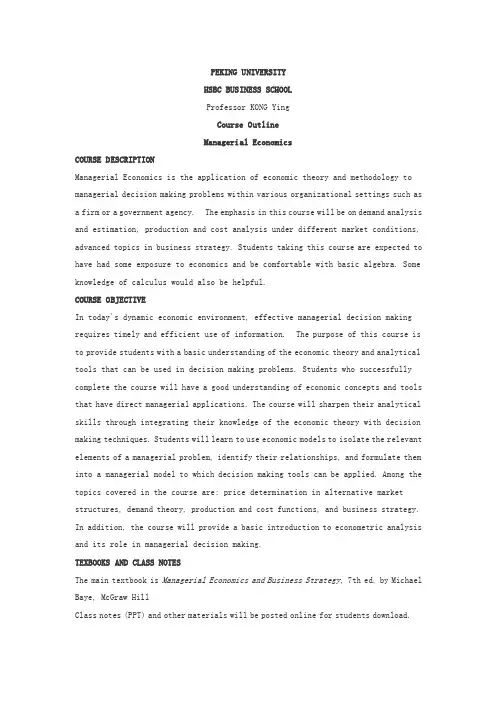
PEKING UNIVERSITYHSBC BUSINESS SCHOOLProfessor KONG YingCourse OutlineManagerial EconomicsCOURSE DESCRIPTIONManagerial Economics is the application of economic theory and methodology to managerial decision making problems within various organizational settings such as a firm or a government agency. The emphasis in this course will be on demand analysis and estimation, production and cost analysis under different market conditions, advanced topics in business strategy. Students taking this course are expected to have had some exposure to economics and be comfortable with basic algebra. Some knowledge of calculus would also be helpful.COURSE OBJECTIVEIn today's dynamic economic environment, effective managerial decision making requires timely and efficient use of information. The purpose of this course is to provide students with a basic understanding of the economic theory and analytical tools that can be used in decision making problems. Students who successfully complete the course will have a good understanding of economic concepts and tools that have direct managerial applications. The course will sharpen their analytical skills through integrating their knowledge of the economic theory with decision making techniques. Students will learn to use economic models to isolate the relevant elements of a managerial problem, identify their relationships, and formulate them into a managerial model to which decision making tools can be applied. Among the topics covered in the course are: price determination in alternative market structures, demand theory, production and cost functions, and business strategy. In addition, the course will provide a basic introduction to econometric analysis and its role in managerial decision making.TEXBOOKS AND CLASS NOTESThe main textbook is Managerial Economics and Business Strategy, 7th ed. by Michael Baye, McGraw HillClass notes (PPT) and other materials will be posted online for students download.COURSE EVELUATIONMidterm Exam: 30%Final Exam: 50% Consulting Projects: 20%SYLLABUSAll chapters listed below refer to the Baye textbook unless otherwise indicated. You are responsible for materials in the Baye text that correspond to the material covered in class. The Baye text should be viewed as a learning aide, NOT as an independent source of examinable material. However, doing questions end of each chapters will greatly help you to prepare exams.Week 1The Fundamentals of Managerial Economics Ch 1Market Forces: Demand and Supply Ch 2Week 2Quantitative Demand Analysis Ch 3The Theory of Individual Behavior Ch 4Week 3The Production Process and Costs Ch 5Week 4The Organization of the Firm Ch 6The Nature of Industry Ch 7Week 5Midterm ExamManaging in Competitive, Monopolistic,Monopolistically Competitive Market Ch 8Week 6Basic Oligopoly Models Ch 9Game Theory: Inside Oligopoly Ch 10Week 7Pricing Strategies for Firms with Market Power Ch 11Week 8The Economics of Information Ch 12Advanced Topics in Business Strategy Ch 13Week 9A Manager’s Guide to Government in the Marketplace Ch 14Project Presentation and Hand InFinal Exam (TBD)CONSULTING PROJECTSIn order to help students to build up the managerial economics analysis skill we provide 4 real world consulting projects in the course. Students are required to independently conduct 4 consulting reports regarding to the 4 projects. The exercises require you to apply some of the tools you learned in each chapter covered in the class to make a recommendation based on an actual business scenario. The topics of 4 consulting projects are,·Estimating Industry Demand for Fresh Market Carrots·Estimation and Analysis of Demand for Fast Food Meals·Production Decisions at Harding Silicon Enterprises, Inc.·Pricing and Production Decisions at PoolVac, Inc.Cheating, Plagiarism and Free RiderThe penalties for any form of cheating or plagiarism (whether in exams or project) are severe. Written work submitted must be your own. Any sources of information used in completing your work must be identified. Plagiarized written work will not be accepted and you should be aware that non acceptance of a submission might, in some cases, lead to failure in the course. Since the project is a team work, the final report should identify each student’s contribution. The significant uneven contribution in the work will lead to less mark for the student who made less contribution comparing to his/her team member.。
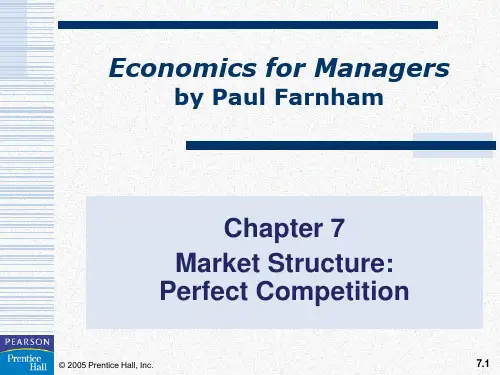
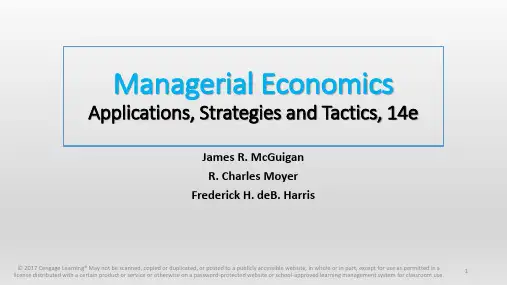
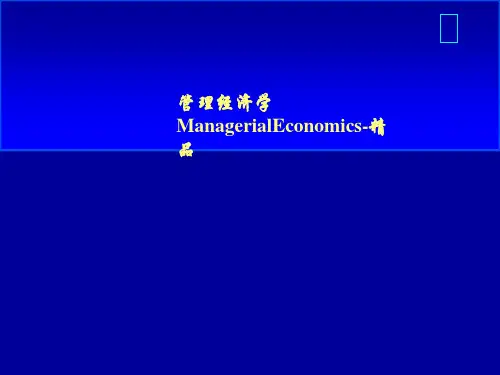
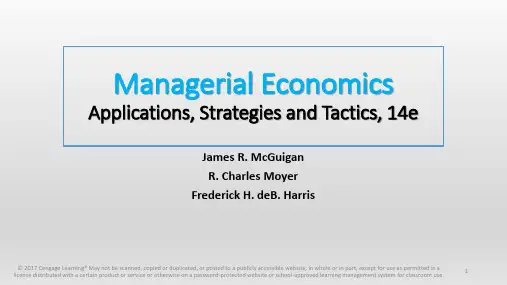
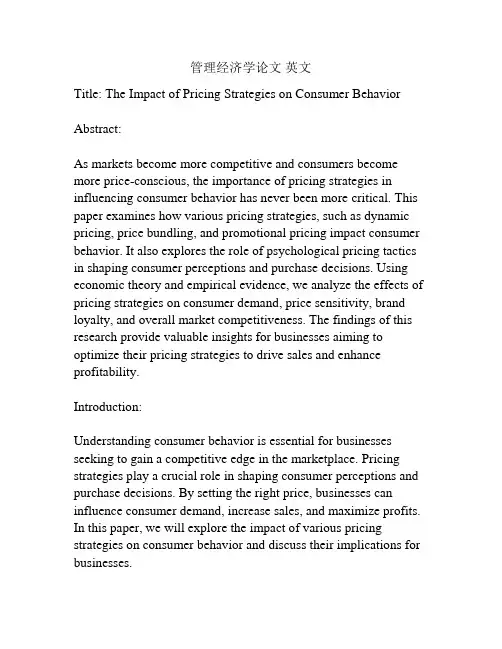
管理经济学论文英文Title: The Impact of Pricing Strategies on Consumer Behavior Abstract:As markets become more competitive and consumers become more price-conscious, the importance of pricing strategies in influencing consumer behavior has never been more critical. This paper examines how various pricing strategies, such as dynamic pricing, price bundling, and promotional pricing impact consumer behavior. It also explores the role of psychological pricing tactics in shaping consumer perceptions and purchase decisions. Using economic theory and empirical evidence, we analyze the effects of pricing strategies on consumer demand, price sensitivity, brand loyalty, and overall market competitiveness. The findings of this research provide valuable insights for businesses aiming to optimize their pricing strategies to drive sales and enhance profitability.Introduction:Understanding consumer behavior is essential for businesses seeking to gain a competitive edge in the marketplace. Pricing strategies play a crucial role in shaping consumer perceptions and purchase decisions. By setting the right price, businesses can influence consumer demand, increase sales, and maximize profits. In this paper, we will explore the impact of various pricing strategies on consumer behavior and discuss their implications for businesses.Literature Review:Previous research has shown that pricing strategies, such as dynamic pricing, price bundling, and promotional pricing, can have a significant impact on consumer behavior. Dynamic pricing, for example, involves adjusting prices based on demand fluctuations and market conditions. Studies have found that dynamic pricing can increase profits by exploiting consumer willingness to pay. Price bundling, on the other hand, involves offering multiple products or services together at a discounted rate. Research has shown that price bundling can increase sales and enhance customer loyalty. Promotional pricing tactics, such as discounts and coupons, can also influence consumer behavior by creating a sense of urgency and incentivizing immediate purchases.Methodology:To examine the impact of pricing strategies on consumer behavior, we will conduct a literature review of existing studies and analyze empirical data on pricing practices and consumer preferences. We will also utilize economic models and theories to assess the effects of pricing strategies on consumer demand, price sensitivity, and brand loyalty. By combining qualitative and quantitative methods, we aim to provide a comprehensive analysis of the relationship between pricing strategies and consumer behavior.Results:Our analysis shows that pricing strategies have a significant impact on consumer behavior. Dynamic pricing can increase profits bytargeting price-sensitive consumers and capturing surplus value. Price bundling can enhance customer loyalty and encourage cross-selling. Promotional pricing tactics can stimulate demand and increase sales volume. Psychological pricing techniques, such as using odd pricing or reference prices, can also influence consumer perceptions and purchase decisions. Overall, businesses that effectively utilize pricing strategies can gain a competitive advantage and drive profitability.Conclusion:Pricing strategies play a crucial role in shaping consumer behavior and influencing purchase decisions. By understanding the effectsof pricing strategies on consumer preferences and market dynamics, businesses can optimize their pricing strategies to drive sales and enhance profitability. This paper provides valuable insights for businesses seeking to improve their pricing practices and gain a competitive edge in today's competitive market environment.。
